Crossref Citations
This article has been cited by the following publications. This list is generated based on data provided by
Crossref.
Grant, Jan
2013.
Short-Term Counseling and Transactional Analysis.
Transactional Analysis Journal,
Vol. 43,
Issue. 1,
p.
58.
Gee, Donna
Mildred, Helen
Brann, Peter
and
Taylor, Mandy
2015.
Brief Intervention: A Promising Framework for Child and Youth Mental Health?.
Administration and Policy in Mental Health and Mental Health Services Research,
Vol. 42,
Issue. 2,
p.
121.
Nieuwboer, Christa C.
Fukkink, Ruben G.
and
Hermanns, Jo M.A.
2015.
Single session email consultation for parents: an evaluation of its effect on empowerment.
British Journal of Guidance & Counselling,
Vol. 43,
Issue. 1,
p.
131.
Falke, Stephanie I.
and
D'Arrigo‐Patrick, Elizabeth
2015.
Medical Family Therapists in Action: Embracing Multiple Roles.
Journal of Marital and Family Therapy,
Vol. 41,
Issue. 4,
p.
428.
Pitt, Tim
Thomas, Owen
Lindsay, Pete
Hanton, Sheldon
and
Bawden, Mark
2015.
Doing sport psychology briefly? A critical review of single session therapeutic approaches and their relevance to sport psychology.
International Review of Sport and Exercise Psychology,
Vol. 8,
Issue. 1,
p.
125.
Ewen, Victoria
Mushquash, Aislin R
Bailey, Kathleen
Haggarty, John M
Dama, Sumeet
and
Mushquash, Christopher J
2016.
Same-Day Counseling: Study Protocol for the Evaluation of a New Mental Health Service.
JMIR Research Protocols,
Vol. 5,
Issue. 1,
p.
e22.
Hopkins, Liza
Lee, Stuart
McGrane, Tess
and
Barbara-May, Rachel
2017.
Single session family therapy in youth mental health: can it help?.
Australasian Psychiatry,
Vol. 25,
Issue. 2,
p.
108.
Ryan, Christian
and
O’Connor, Shona
2017.
Single Session Psychology Clinic for Parents of Children with Autism Spectrum Disorder: A Feasibility Study.
Journal of Child and Family Studies,
Vol. 26,
Issue. 6,
p.
1614.
Coates, Dominiek
and
Howe, Deborah
2017.
Improving throughput in a youth mental health service.
International Journal of Health Care Quality Assurance,
Vol. 30,
Issue. 3,
p.
224.
Paprocki, Christine M.
and
Baucom, Donald H.
2017.
Worried About us: Evaluating an Intervention for Relationship‐Based Anxiety.
Family Process,
Vol. 56,
Issue. 1,
p.
45.
Ewen, Victoria
Mushquash, Aislin R.
Mushquash, Christopher J.
Bailey, S. Kathleen
Haggarty, John M.
and
Stones, Michael J.
2018.
Single-session therapy in outpatient mental health services: Examining the effect on mental health symptoms and functioning.
Social Work in Mental Health,
Vol. 16,
Issue. 5,
p.
573.
Poon, Abner Weng Cheong
Harvey, Carol
Fuzzard, Suzanne
and
O'Hanlon, Brendan
2019.
Implementing a family‐inclusive practice model in youth mental health services in Australia.
Early Intervention in Psychiatry,
Vol. 13,
Issue. 3,
p.
461.
Courtnage, Alesya
2020.
Hoping for Change: The Role of Hope in Single-Session Therapy.
Journal of Systemic Therapies,
Vol. 39,
Issue. 1,
p.
49.
Hoyt, Michael F.
Young, Jeff
and
Rycroft, Pam
2020.
Single Session Thinking 2020.
Australian and New Zealand Journal of Family Therapy,
Vol. 41,
Issue. 3,
p.
218.
John Westwater, Jason
Murphy, Myfanwy
Handley, Christine
and
McGregor, Lucy
2020.
A Mixed Methods Exploration of Single Session Family Therapy in a Child and Adolescent Mental Health Service in Tasmania, Australia.
Australian and New Zealand Journal of Family Therapy,
Vol. 41,
Issue. 3,
p.
258.
Mull, Amal A.
Cleveland, Carolyn
Robinette, Randy
and
Dixon, Laura H.
2020.
Pathways: An Innovation in the Delivery of College Counseling Services.
Journal of College Student Psychotherapy,
Vol. 34,
Issue. 1,
p.
40.
Stauffer, Mark D.
Ambrose, Heather J.
and
Robbins, John M.
2021.
Foundations of Couples, Marriage, and Family Counseling 2nd Edition.
p.
191.
Bundy, Nicky
2022.
Time, Complexity, and the Meaning of Help: A Systematic Review of People's Experiences of Single-Session Therapy.
Journal of Systemic Therapies,
Vol. 41,
Issue. 2,
p.
68.
Mulligan, Janice
Olivieri, Heather
Young, Katarina
Lin, Jia
and
Anthony, Samantha J.
2022.
Single session therapy in pediatric healthcare: the value of adopting a strengths-based approach for families living with neurological disorders.
Child and Adolescent Psychiatry and Mental Health,
Vol. 16,
Issue. 1,
Sargison, Helen
Fernandez, Yolanda
Marsh, Bonny
Ferguson, Josephine
Foley, Wendy
Askew, Deborah
Tyson, Claudette
Rose, Tanya
Scarinci, Nerina
and
Copley, Jodie
2022.
Maximising allied health accessibility for Aboriginal and Torres Strait Islander children: exploring experiences and perceptions of a family-centred consultation model.
Speech, Language and Hearing,
Vol. 25,
Issue. 2,
p.
166.




